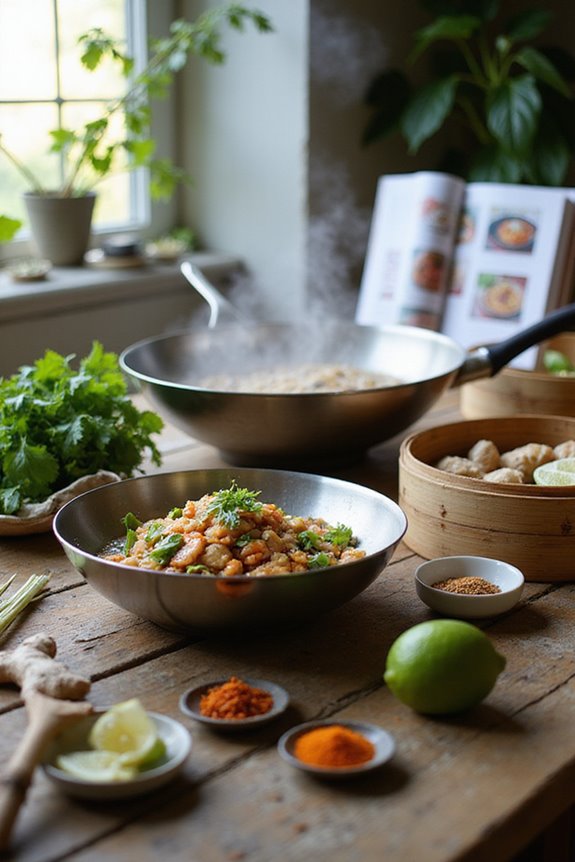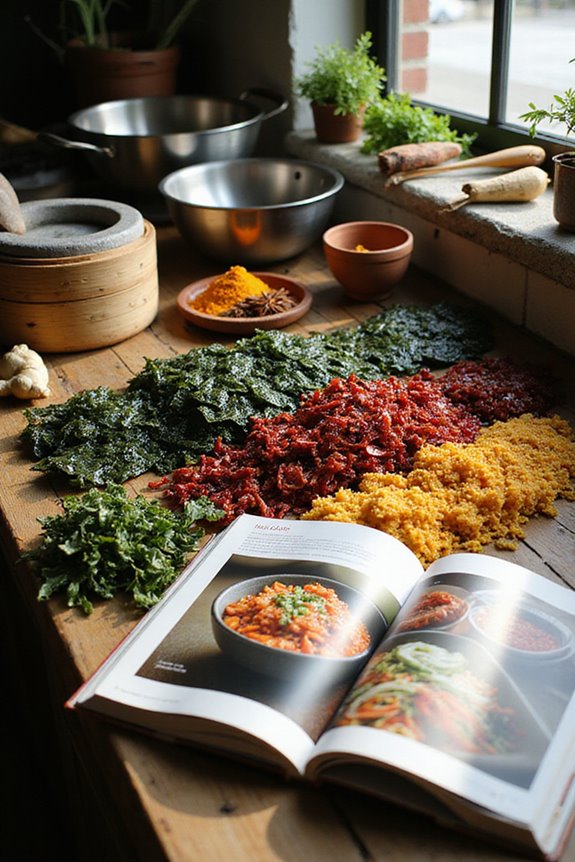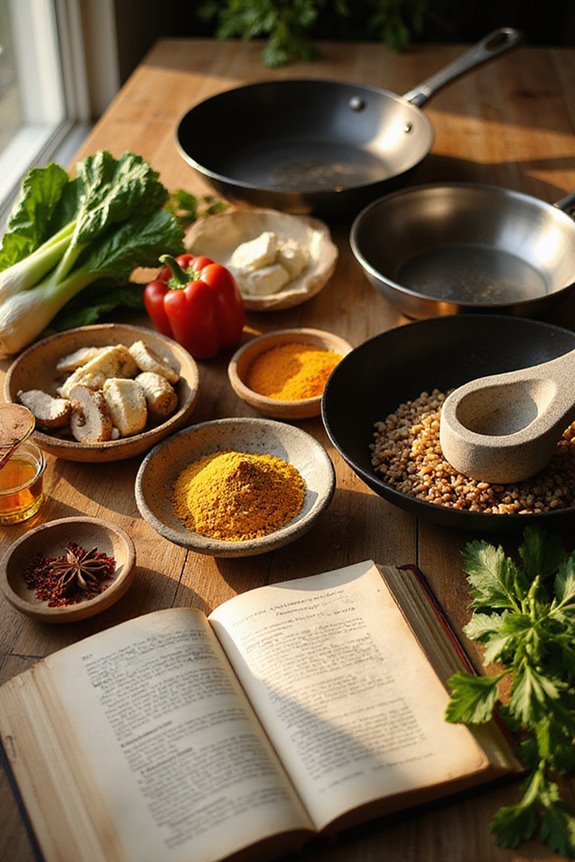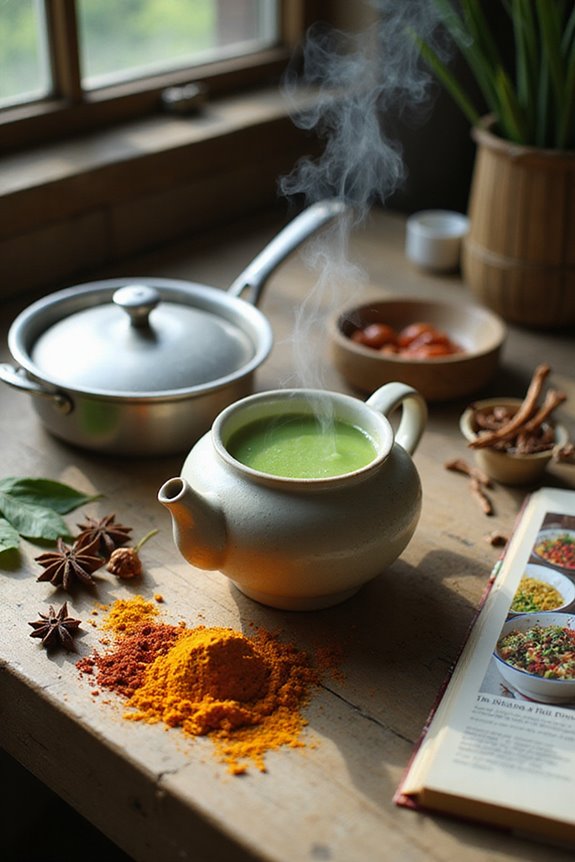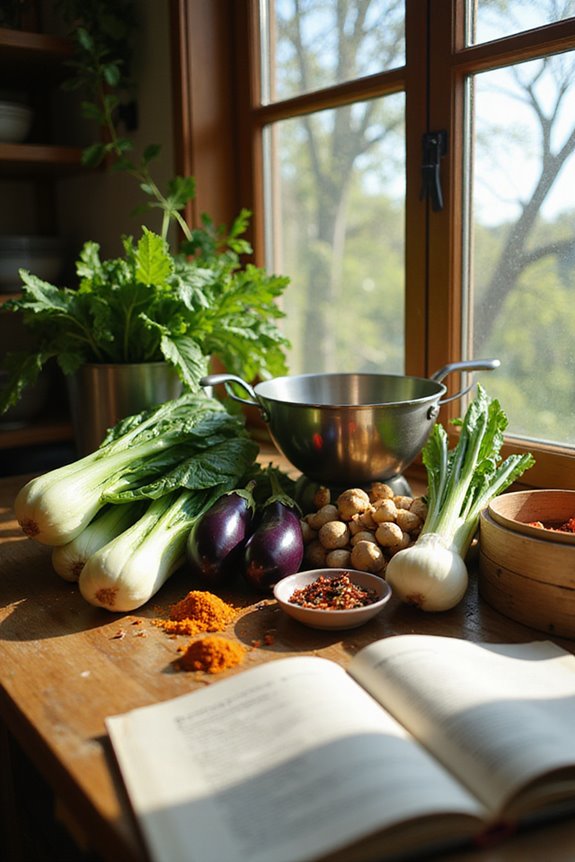Let’s make our Asian dishes magical and low-sodium! We can do this by using fresh herbs and spices to bring out delightful flavors. Try swapping fish sauce with lemon juice for a zesty kick. Remember, measuring soy sauce carefully helps control sodium too. We can choose low-sodium options when shopping and even rinse canned goods to wash away some sodium goodness. Isn’t it fabulous how we can enjoy our favorite dishes while keeping them healthy? Stick around for more tasty tips!
Key Takeaways
- Use low-sodium soy sauce or coconut aminos as healthier alternatives to regular soy sauce in your dishes.
- Incorporate fresh herbs, such as cilantro and basil, for flavor enhancement without added sodium.
- Rinse canned vegetables and beans thoroughly to remove excess sodium before using them in recipes.
- Opt for unsalted or homemade broth to control sodium levels instead of pre-packaged options.
- Cook high-temperature techniques like stir-frying with minimal sauce to showcase the natural flavors of ingredients.
Understanding Sodium Sources in Asian Cuisine
When we plunge into the delightful world of Asian cuisine, it’s hard not to notice just how much sodium sneaks its way into our favorite dishes! These culinary traditions often use a variety of sodium sources like fish sauce, soy sauce, and miso paste.
- Did you know one tablespoon of shrimp paste packs a whopping 1,508 mg of sodium? Yikes!
- Fish sauce adds around 1,410 mg, and even soy sauce can range from 880 mg per tablespoon.
To keep our meals tasty but less salty, we can substitute with fresh herbs or citrus. By reducing high-sodium condiments, we can enjoy the magic of flavor without overwhelming our taste buds or our health. Let’s make delicious, healthier choices together! Additionally, many cookbooks offer dietary-friendly options that help you tailor recipes to your needs, ensuring that flavor and health go hand in hand.
Recognizing Sodium Content Variability in Dishes
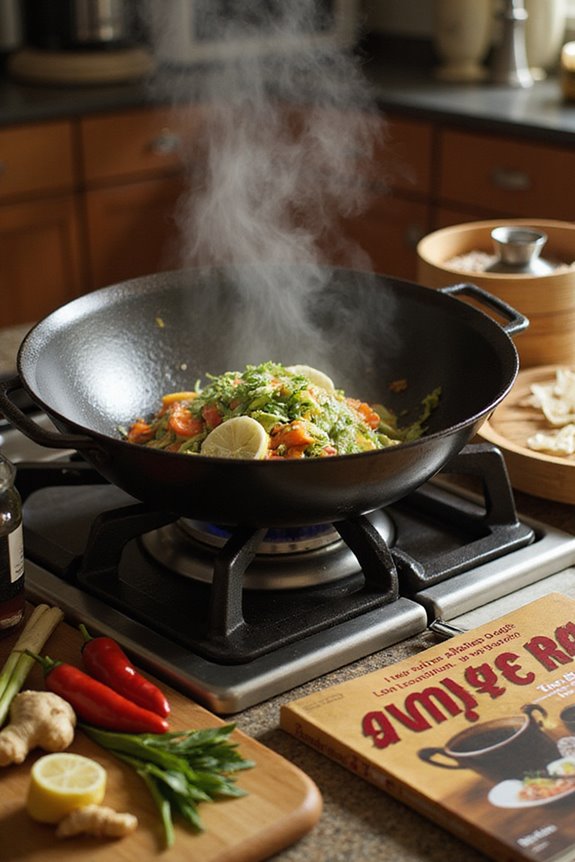
How well do we really know the sodium content of our favorite Asian dishes? It’s a delightful surprise to discover how regional influences play a significant role in sodium levels. For example:
- Southern Chinese dishes can pack a punch with an average of 566.3 mg of sodium per 100 g!
- Soups and cold dishes often tip the scales even higher, averaging around 687.0 mg and 528.4 mg, respectively.
These differences remind us that cooking styles and personal tastes can dramatically change our sodium intake. So, as we explore our culinary adventures, let’s be mindful of these variations. By staying informed, we can enjoy flavorful dishes while keeping our sodium levels in check, making every meal a magical experience! Additionally, incorporating low sodium soy sauces into our cooking can significantly help in reducing overall sodium intake while maintaining delicious flavors.
Effective Strategies for Reducing Sodium in Cooking
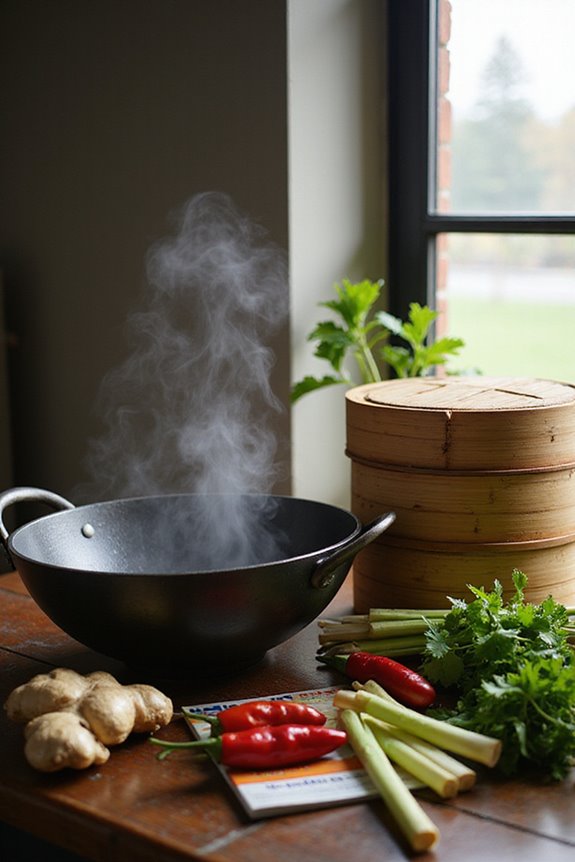
While we may love the bold flavors of our favorite Asian dishes, we can easily bring them down a notch in sodium without sacrificing taste! Here are some delightful strategies for flavor enhancement:
- Freshness is key: Use fresh vegetables and proteins—they naturally have less sodium.
- Make your own broth: Opt for unsalted broth or create your own to control the salt.
- Choose wisely: Select low-sodium canned goods and rinse them thoroughly!
- Sodium alternatives: Replace regular soy sauce with low-sodium alternatives or even coconut aminos.
- Cook creatively: Stir-fry those veggies with minimal sauce to let their magic shine!
Incorporating fermented foods such as miso can also add depth of flavor while providing probiotics.
With these tips, we can enjoy our beloved dishes and make them healthier. Let’s get cooking!
Alternative Seasoning Approaches to Enhance Flavor
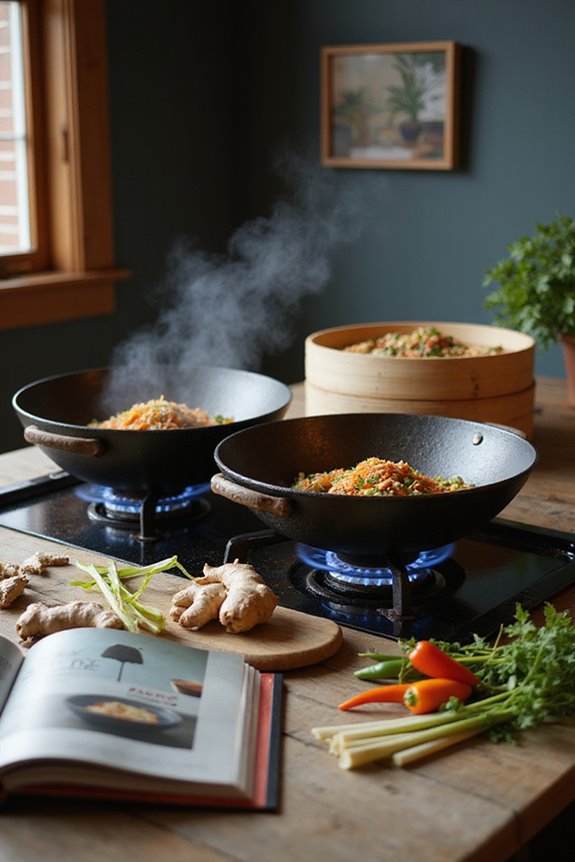
Diving into alternative seasoning approaches can be a delightful adventure in flavor creation! We can enhance our dishes through herb infusions and vinegar alternatives that awaken our taste buds. Consider using fresh herbs like cilantro, basil, and mint to kick things up a notch without adding sodium.
- For a magical zing, swirl in rice wine vinegar or apple cider vinegar instead of salty sauces.
- Blend in a spoonful of plum jam for sweetness and acidity that dances on the palate.
Don’t forget about adding finely chopped chili peppers for that extra kick! With these tasty techniques, we can enjoy vibrant, healthier meals that still pack a flavorful punch. A variety of dried herbs like freeze-dried herbs can also enhance flavor without the sodium. Let’s embrace this flavor adventure together and make every bite count!
Portion Control and Mindful Eating Practices

With the right practices in mind, we can take our sodium reduction journey to the next level through portion control and mindful eating. It’s all about appreciating our food with *portion awareness*. Here are some tips:
- Measure Out: Use measuring spoons for soy sauce—who knew precision could be so magical?
- Small Portions: Sharing a delightful family-style meal allows us to enjoy our favorites without overindulging.
- Savor Every Bite: Eating slowly helps us tune into those fullness cues, so we don’t reach for that extra helping of salty goodness.
- Mindful Meals: Combine sodium-rich dishes with low-sodium veggies for a taste sensation that’s balanced and satisfying! Additionally, consider using cooking techniques compatible with high-temperature cooking to enhance flavors without added salt.
Let’s celebrate every flavorful bite while keeping our health in check. Happy cooking, friends!
Public Health Initiatives and Education on Sodium Reduction
When it comes to reducing sodium, public health initiatives and education are our helpful guides on this flavorful journey! These initiatives aim to lower sodium consumption, with the FDA setting targets to help us enjoy our meals with less salt. Here are some exciting ways we can tackle this together:
- Sodium Education: Let’s learn about cooking tasty dishes with herbs instead of salt.
- School Programs: Schools are leading the way by serving healthier meals without losing flavor.
- Community Awareness: Mass media is buzzing about the risks of high sodium, helping us make informed choices. Additionally, incorporating gluten-free soy sauces can significantly reduce sodium intake while enhancing flavor in Asian dishes.
Collaborating With Restaurants for Healthier Options
Creating healthier dining options at restaurants can feel a bit like starting on a tasty adventure! We can team up with restaurants through exciting restaurant partnerships to push for menu innovations. By simply requesting less sodium in our favorite dishes, we can influence chefs to create delightful, lower-sodium versions that still tickle our taste buds!
Here’s how we can encourage these changes:
- Share Feedback: Let restaurants know we appreciate lower-sodium options!
- Promote Menu Innovations: Support places that showcase healthy choices.
- Celebrate Partnerships: Cheer on restaurants like Darden and Yum Brands, leading the way!
Together, we can make a magical impact on our dining experiences and improve our health—all while savoring every bite!
Frequently Asked Questions
Can I Use Regular Salt Instead of Low-Sodium Alternatives?
We can use regular salt, but it’s wise to contemplate salt alternatives for healthier choices. By doing this, we still enhance flavor while being mindful of our sodium intake, ensuring our meals taste great and benefit our health.
How Can I Identify Sodium Content in Packaged Asian Foods?
When we explore sodium labels together, we should check the nutrition facts on packaged Asian foods. By looking closely, we can uncover hidden sodium sources, making informed choices for our health and shared culinary journey.
What Herbs Best Complement Asian Cooking Without Adding Sodium?
When we explore herb combinations for flavor enhancement in Asian cooking, we find that basil, cilantro, and mint bring delightful aromas. Adding lemongrass or Thai basil can transform our dishes, making them truly vibrant and delicious.
Are There Any Sodium-Free Sauce Brands Available for Asian Dishes?
Isn’t it invigorating to find sodium-free soy sauce options? We can explore extraordinary alternative flavorings like seaweed-based sauces that maintain deliciousness while catering to our health. Let’s embrace flavorful cooking without compromising our well-being together!
What Are Health Risks Associated With High Sodium Intake From Asian Cuisine?
We’re all at risk from the health effects of high sodium intake, especially from Asian cuisine. Adhering to dietary guidelines can help us mitigate hypertension, heart disease, and stroke, keeping our community healthier together.

